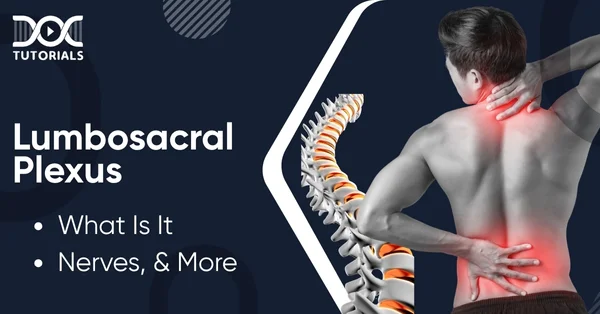Lumbosacral Plexus: What Is It, Nerves, and More

The lumbosacral plexus is a central neural network coordinating the motor and sensory processes of the lower abdomen, pelvis, and lower extremities. This intricate system, which is created by the lower thoracic and lumbar ventral nerve roots, governs movements like walking, running, and posture.
If you’re an aspiring medical student, preparing for NEET PG exam, understanding the lumbosacral plexus concept is crucial. DocTutorials provides detailed study resources that go in-depth about subjects such as the lumbosacral plexus, equipping candidates with the information required to succeed in their exams and subsequent medical careers.
Keep reading for a detailed insight.
What is Lumbosacral Plexus?
The lumbosacral plexus refers to a network of complex nerves that is formed by the anterior rami of spinal nerves T12 to S4. The anatomy of the lumbosacral plexus can be further divided into 2 significant components: the lumbar plexus (T12–L4) and the sacral plexus (L4–S4).
Situated within the muscle of the psoas major and along the back of the pelvis, this plexus is responsible for motor and sensory innervation of the pelvis, lower limbs, and portions of the abdomen.
The lumbar plexus is anterior to the lumbar vertebrae and is the origin of nerves like the femoral and obturator nerves, whereas the sacral plexus consists of large branches like the sciatic, pudendal, and gluteal nerves. Any damage to this complex, lumbosacral plexopathy, may cause severe impairment of function with both mobility and sensation.
What are the Nerves Present in the Lumbosacral Plexus?
The lumbosacral plexus is an array of nerves constituted by lumbar and sacral spinal nerves (L1 to S4), which provide motor and sensory functions to the pelvis, lower limb, and perineum.
The following are the major nerves emanating from the plexus, along with their functions:
- From the Lumbar Plexus (L1–L4)
- Iliohypogastric Nerve (L1): Provides motor function to abdominal wall muscles and sensation to lower abdominal and upper buttock skin.
- Ilioinguinal Nerve (L1): Similar to the iliohypogastric, this joint nerve innervates the same abdominal muscles and provides sensation to the higher medial thigh and parts of the external genitalia.
- Genitofemoral Nerve (L1–L2): This involves the genital branch that innervates the cremaster muscle and scrotal skin (in males) or the mons pubis and labia majora (in females) and the femoral branch that gives sensation to the skin of the upper anterior thigh.
- Lateral Femoral Cutaneous Nerve (L2–L3): This stimulates sensation to the skin over the outer (lateral) surface of the thigh.
- Femoral Nerve (L2–L4, Posterior Branches): It supports motor innervation to the muscles at the front of the thigh (such as the quadriceps) and to the sensory branches of the anterior thigh and lower leg.
- Obturator Nerve (L2–L4, Anterior Branches): This nerve supplies motor and sensory nerves to the inner thigh muscles and the skin on the inner side of the thigh.
- Lumbosacral Trunk (L4–L5): It connects the lumbar plexus to the sacral plexus and contributes fibres to the sciatic nerve.
- From the Sacral Plexus (L4–S4)
- Sciatic Nerve (L4–S3): The largest nerve in the body. Supplies the hip joint, posterior thigh muscles, and all muscles of the leg and foot via its two branches (tibial and common fibular nerves).
- Pudendal Nerve (S2–S4): It provides motor supply to the perineal muscles and sensory input to the external genitalia and perineal skin.
- Superior Gluteal Nerve (L4–S1): It innervates the gluteus medius, gluteus minimus, and tensor fasciae latae muscles (responsible for hip abduction and stabilisation).
- Inferior Gluteal Nerve (L5–S2): It provides the gluteus maximus muscle, which is responsible for hip extension.
- Nerve to Quadratus Femoris (L4–S1): This innervates the quadratus femoris and inferior gemellus muscles.
- Nerve to Obturator Internus (L5–S2): It innervates obturator internus and upper gemellus muscles.
- Nerve to Piriformis (S1–S2): This supplies the piriformis muscle, which is a lateral rotator of the hip.
- Nerves to Levator Ani and Coccygeus (S3–S4): They supply pelvic floor muscles that stabilise pelvic organs and assist incontinence.
- Posterior Femoral Cutaneous Nerve (S1–S3): It supplies sensory innervation of skin on the posterior thigh and upper leg.
- Perforating Cutaneous Nerve (S2–S3): This stimulates sensation to the skin over the lower buttock.
FAQs About Lumbosacral Plexus
- Which is the largest nerve arising from the lumbar plexus?
The femoral nerve, composed of spinal nerves L2–L4, is the largest lumbar plexus nerve. It innervates the quadriceps femoris and other thigh muscles anteriorly, making a major contribution to hip flexion and knee extension.
- Why is the lumbosacral plexus clinically significant?
The lumbosacral plexus is critical to the motor and sensory function of the pelvic and lower limb regions. It facilitates important functioning of structures in the lumbosacral plexus that allow a multitude of movements, including hip flexion, knee extension, and thigh adduction, which are all necessary movements for standing, walking, and balancing.
- What are the effects of damage to the lumbosacral plexus?
Damage to the lumbosacral plexus, whether from trauma, birth injury, or disease processes, can lead to pain, weakness, and sensory changes in the lower back and legs. Pain may be accompanied by tingling, burning, and cramping, and every patient may have different presentations of muscle weakness and severely reduced mobility.
- What leads to lumbosacral plexopathy?
Lumbosacral plexopathy is a condition where the lumbosacral plexus does not function properly. Symptoms typically comprise pain, weakness, and problems with the muscles that the plexus supplies, and are not limited to a particular nerve.
- What muscles does the lumbar plexus innervate?
The lumbar plexus supplies several important muscles, including, but not limited to, psoas major and minor, quadratus lumborum, transversus abdominis, internal oblique, and the muscles of the anterior thigh, which comprise quadriceps femoris. The muscular functions supported by these muscles produce trunk stabilisation and lower limb movement.
Conclusion
A clear knowledge of the anatomy and physiology of the lumbosacral plexus is the key to diagnosing and managing many underlying conditions of the lower limbs and pelvis. It is a milestone in the path of medical learning, particularly if you’re aiming to perform well in competitive exams such as NEET PG.
At DocTutorials, we provide highly NEET PG study materials that explore in detail the intricacies of subjects like the lumbosacral plexus, ensuring aspirants are adequately prepared for their exams and future medical work.
By offering deep resources and experienced guidance, DocTutorials plays a central role in empowering aspiring doctors with the skills and knowledge required to succeed in their medical profession.
Latest Blogs
-

INI CET Exam 2025: Your Roadmap to Success – Key Topics, Strategies, and Lessons from Last Year’s Papers
The INI CET exam is more than just a test; it’s a significant milestone for many medical students aiming to…
-

INI CET Exam Success: Previous Year Question Papers & Ultimate Guide – INI CET PYQ
One can feel overwhelmed while preparing for the INI CET (Institute of National Importance Combined Entrance Test). A vast syllabus,…
-

INI CET Exam Pattern 2024: A Complete Guide with Subject-Wise Weightage
The Institute of National Importance Combined Entrance Test (INI CET) is your key to entering some of the most prestigious…




